Financial Statement Analysis Report
VerifiedAdded on 2019/12/03
|16
|4525
|2086
Report
AI Summary
This report provides a comprehensive financial statement analysis of Volkswagen and Toyota, comparing their financial performance and position. It utilizes ratio analysis to assess profitability, liquidity, and solvency, revealing Volkswagen's weaker profitability compared to Toyota. The report also delves into the impact of Volkswagen's emissions scandal on its financial health, including the decline in share prices and credit ratings. Furthermore, it discusses innovation and growth strategies for Volkswagen, focusing on the need for cost reduction and the development of eco-friendly vehicles. The report concludes with recommendations for Volkswagen to improve its financial performance and for investors to consider Toyota's stronger financial position.
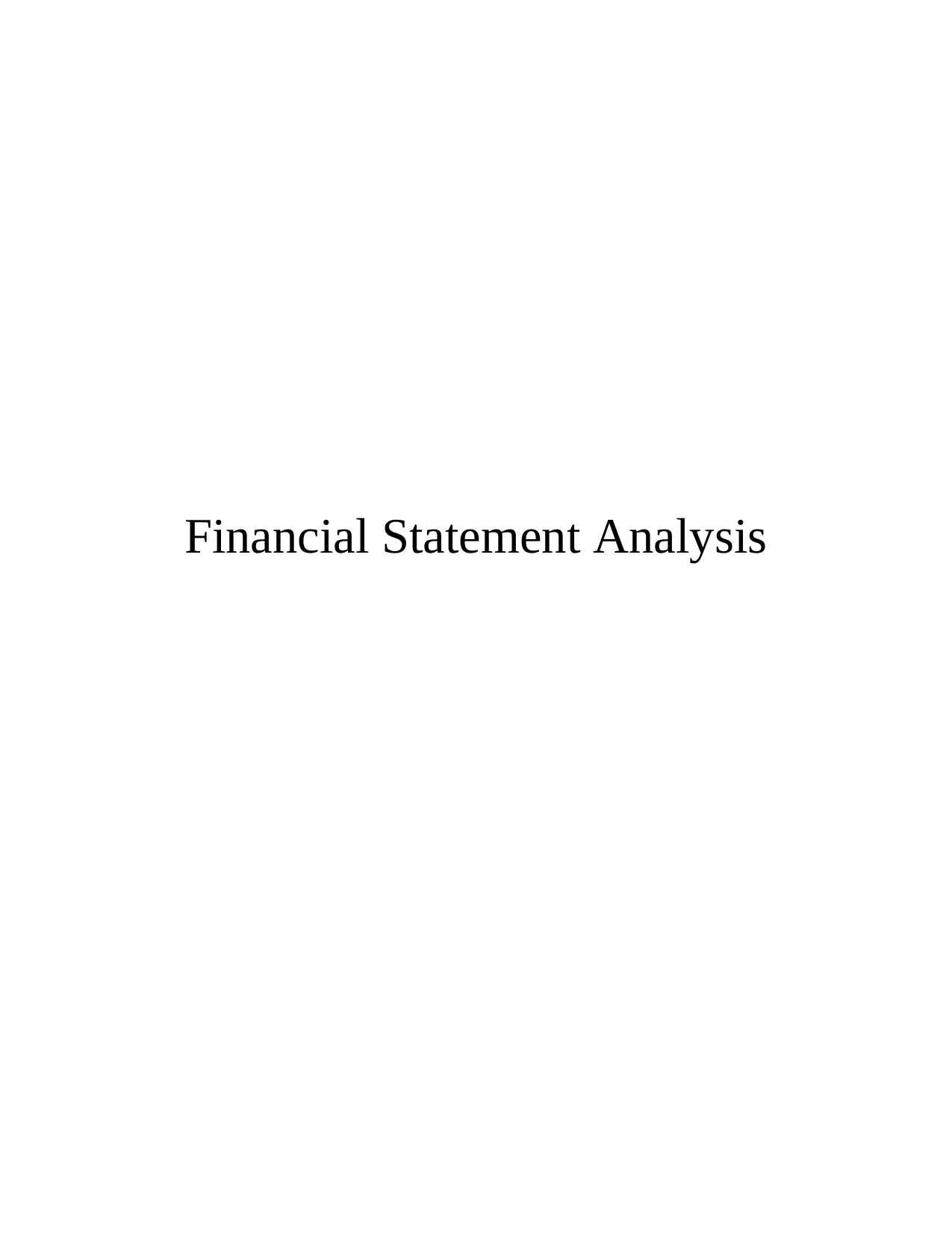
Financial Statement Analysis
Paraphrase This Document
Need a fresh take? Get an instant paraphrase of this document with our AI Paraphraser
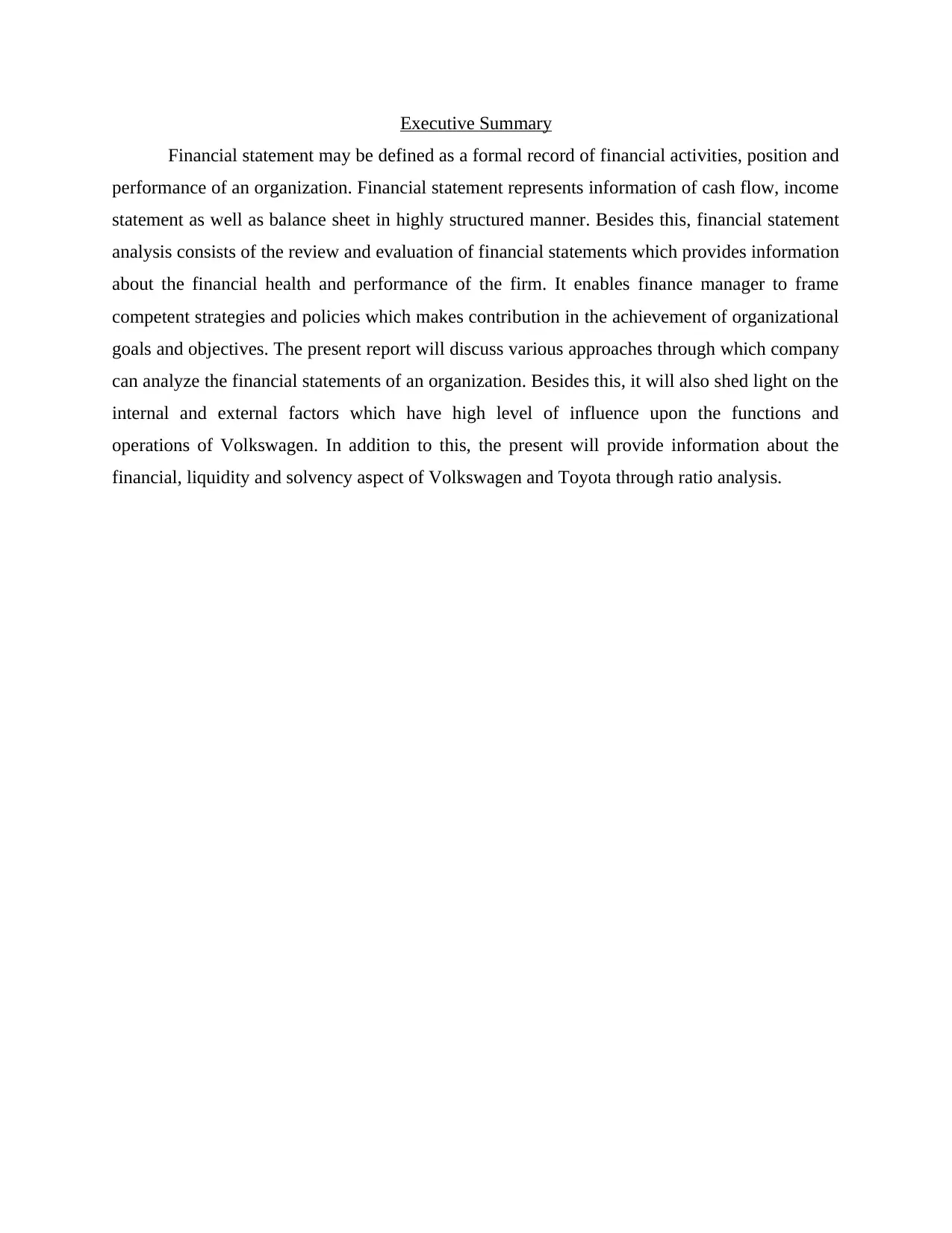
Executive Summary
Financial statement may be defined as a formal record of financial activities, position and
performance of an organization. Financial statement represents information of cash flow, income
statement as well as balance sheet in highly structured manner. Besides this, financial statement
analysis consists of the review and evaluation of financial statements which provides information
about the financial health and performance of the firm. It enables finance manager to frame
competent strategies and policies which makes contribution in the achievement of organizational
goals and objectives. The present report will discuss various approaches through which company
can analyze the financial statements of an organization. Besides this, it will also shed light on the
internal and external factors which have high level of influence upon the functions and
operations of Volkswagen. In addition to this, the present will provide information about the
financial, liquidity and solvency aspect of Volkswagen and Toyota through ratio analysis.
Financial statement may be defined as a formal record of financial activities, position and
performance of an organization. Financial statement represents information of cash flow, income
statement as well as balance sheet in highly structured manner. Besides this, financial statement
analysis consists of the review and evaluation of financial statements which provides information
about the financial health and performance of the firm. It enables finance manager to frame
competent strategies and policies which makes contribution in the achievement of organizational
goals and objectives. The present report will discuss various approaches through which company
can analyze the financial statements of an organization. Besides this, it will also shed light on the
internal and external factors which have high level of influence upon the functions and
operations of Volkswagen. In addition to this, the present will provide information about the
financial, liquidity and solvency aspect of Volkswagen and Toyota through ratio analysis.
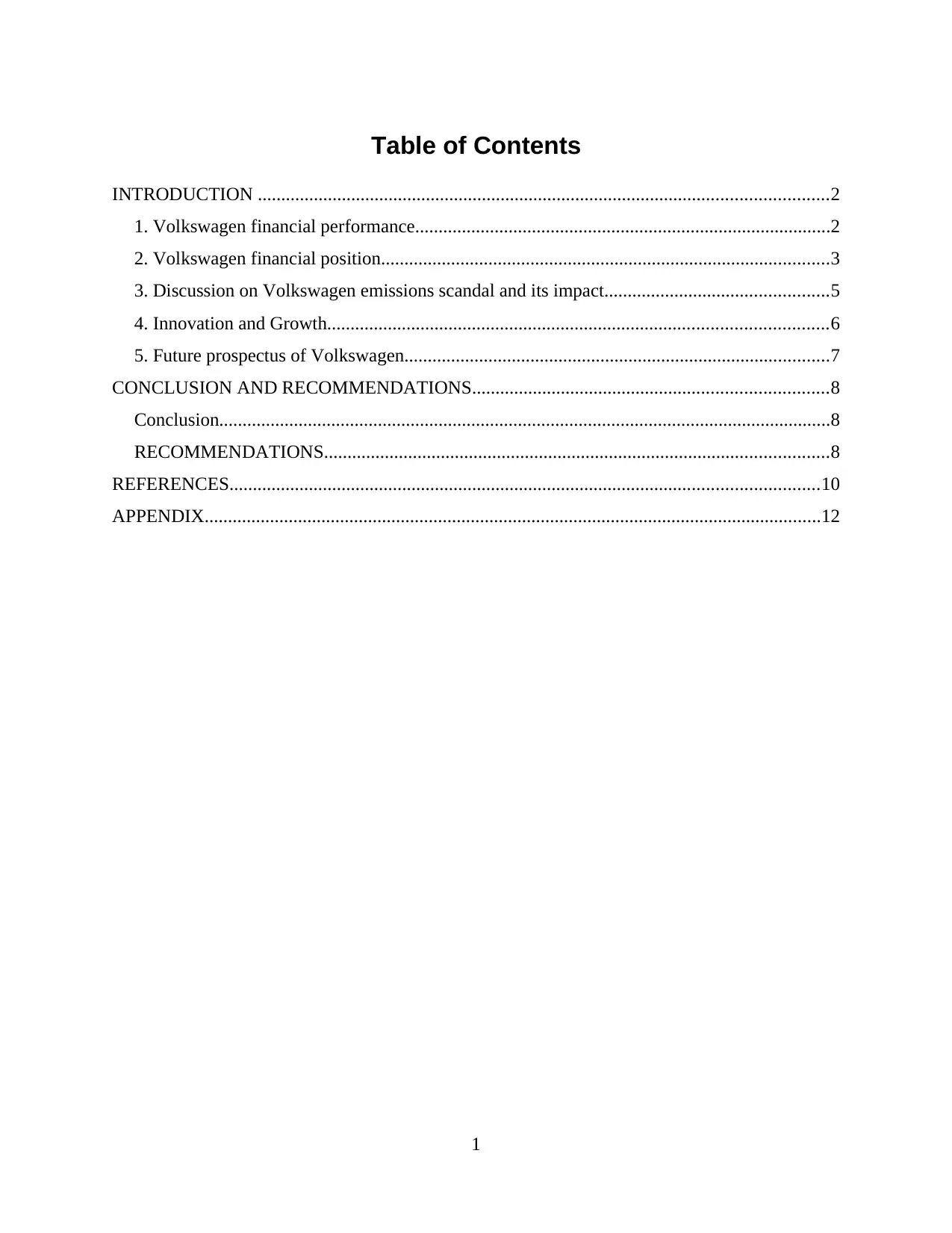
Table of Contents
INTRODUCTION ..........................................................................................................................2
1. Volkswagen financial performance.........................................................................................2
2. Volkswagen financial position................................................................................................3
3. Discussion on Volkswagen emissions scandal and its impact................................................5
4. Innovation and Growth...........................................................................................................6
5. Future prospectus of Volkswagen...........................................................................................7
CONCLUSION AND RECOMMENDATIONS............................................................................8
Conclusion...................................................................................................................................8
RECOMMENDATIONS............................................................................................................8
REFERENCES..............................................................................................................................10
APPENDIX....................................................................................................................................12
1
INTRODUCTION ..........................................................................................................................2
1. Volkswagen financial performance.........................................................................................2
2. Volkswagen financial position................................................................................................3
3. Discussion on Volkswagen emissions scandal and its impact................................................5
4. Innovation and Growth...........................................................................................................6
5. Future prospectus of Volkswagen...........................................................................................7
CONCLUSION AND RECOMMENDATIONS............................................................................8
Conclusion...................................................................................................................................8
RECOMMENDATIONS............................................................................................................8
REFERENCES..............................................................................................................................10
APPENDIX....................................................................................................................................12
1
⊘ This is a preview!⊘
Do you want full access?
Subscribe today to unlock all pages.

Trusted by 1+ million students worldwide
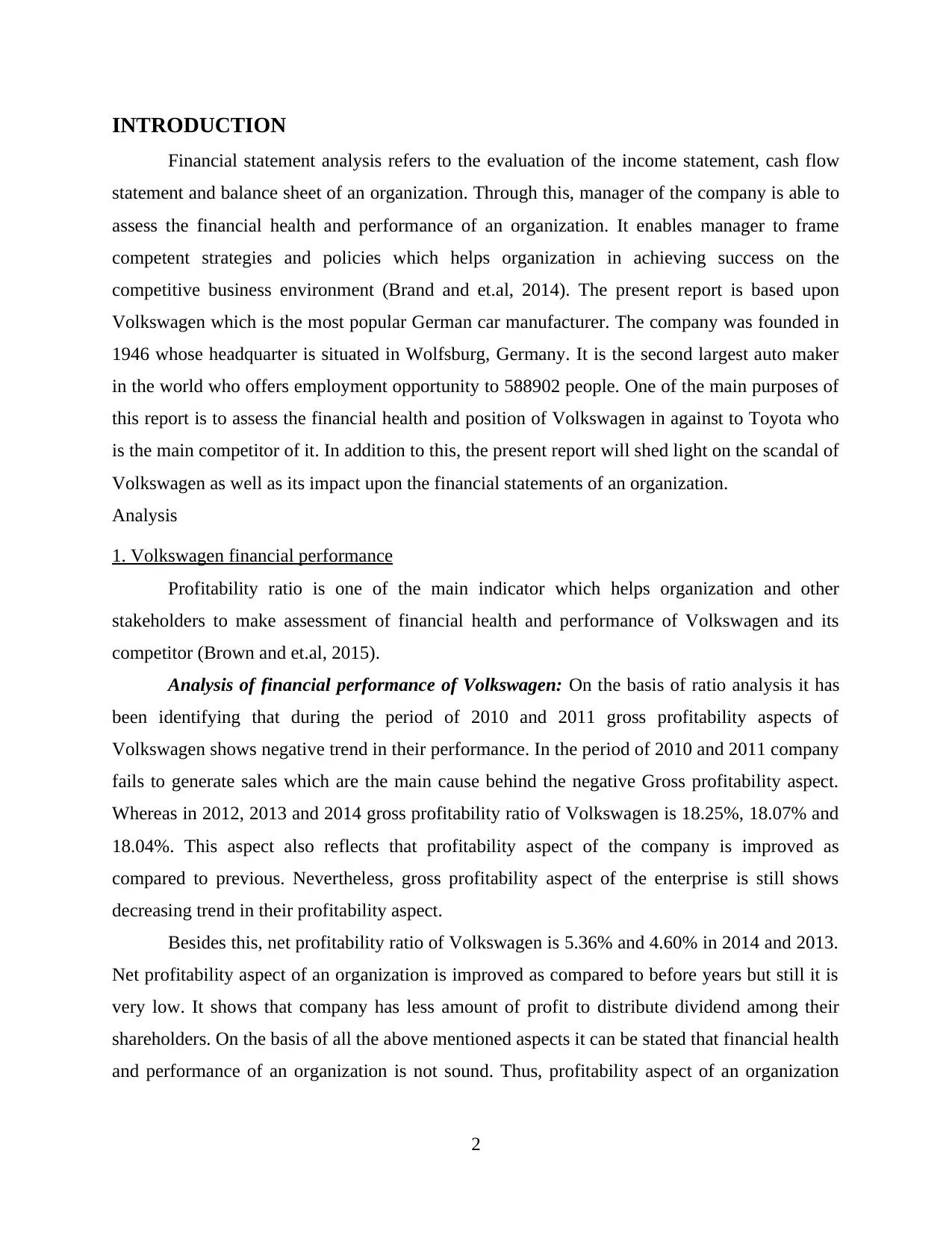
INTRODUCTION
Financial statement analysis refers to the evaluation of the income statement, cash flow
statement and balance sheet of an organization. Through this, manager of the company is able to
assess the financial health and performance of an organization. It enables manager to frame
competent strategies and policies which helps organization in achieving success on the
competitive business environment (Brand and et.al, 2014). The present report is based upon
Volkswagen which is the most popular German car manufacturer. The company was founded in
1946 whose headquarter is situated in Wolfsburg, Germany. It is the second largest auto maker
in the world who offers employment opportunity to 588902 people. One of the main purposes of
this report is to assess the financial health and position of Volkswagen in against to Toyota who
is the main competitor of it. In addition to this, the present report will shed light on the scandal of
Volkswagen as well as its impact upon the financial statements of an organization.
Analysis
1. Volkswagen financial performance
Profitability ratio is one of the main indicator which helps organization and other
stakeholders to make assessment of financial health and performance of Volkswagen and its
competitor (Brown and et.al, 2015).
Analysis of financial performance of Volkswagen: On the basis of ratio analysis it has
been identifying that during the period of 2010 and 2011 gross profitability aspects of
Volkswagen shows negative trend in their performance. In the period of 2010 and 2011 company
fails to generate sales which are the main cause behind the negative Gross profitability aspect.
Whereas in 2012, 2013 and 2014 gross profitability ratio of Volkswagen is 18.25%, 18.07% and
18.04%. This aspect also reflects that profitability aspect of the company is improved as
compared to previous. Nevertheless, gross profitability aspect of the enterprise is still shows
decreasing trend in their profitability aspect.
Besides this, net profitability ratio of Volkswagen is 5.36% and 4.60% in 2014 and 2013.
Net profitability aspect of an organization is improved as compared to before years but still it is
very low. It shows that company has less amount of profit to distribute dividend among their
shareholders. On the basis of all the above mentioned aspects it can be stated that financial health
and performance of an organization is not sound. Thus, profitability aspect of an organization
2
Financial statement analysis refers to the evaluation of the income statement, cash flow
statement and balance sheet of an organization. Through this, manager of the company is able to
assess the financial health and performance of an organization. It enables manager to frame
competent strategies and policies which helps organization in achieving success on the
competitive business environment (Brand and et.al, 2014). The present report is based upon
Volkswagen which is the most popular German car manufacturer. The company was founded in
1946 whose headquarter is situated in Wolfsburg, Germany. It is the second largest auto maker
in the world who offers employment opportunity to 588902 people. One of the main purposes of
this report is to assess the financial health and position of Volkswagen in against to Toyota who
is the main competitor of it. In addition to this, the present report will shed light on the scandal of
Volkswagen as well as its impact upon the financial statements of an organization.
Analysis
1. Volkswagen financial performance
Profitability ratio is one of the main indicator which helps organization and other
stakeholders to make assessment of financial health and performance of Volkswagen and its
competitor (Brown and et.al, 2015).
Analysis of financial performance of Volkswagen: On the basis of ratio analysis it has
been identifying that during the period of 2010 and 2011 gross profitability aspects of
Volkswagen shows negative trend in their performance. In the period of 2010 and 2011 company
fails to generate sales which are the main cause behind the negative Gross profitability aspect.
Whereas in 2012, 2013 and 2014 gross profitability ratio of Volkswagen is 18.25%, 18.07% and
18.04%. This aspect also reflects that profitability aspect of the company is improved as
compared to previous. Nevertheless, gross profitability aspect of the enterprise is still shows
decreasing trend in their profitability aspect.
Besides this, net profitability ratio of Volkswagen is 5.36% and 4.60% in 2014 and 2013.
Net profitability aspect of an organization is improved as compared to before years but still it is
very low. It shows that company has less amount of profit to distribute dividend among their
shareholders. On the basis of all the above mentioned aspects it can be stated that financial health
and performance of an organization is not sound. Thus, profitability aspect of an organization
2
Paraphrase This Document
Need a fresh take? Get an instant paraphrase of this document with our AI Paraphraser
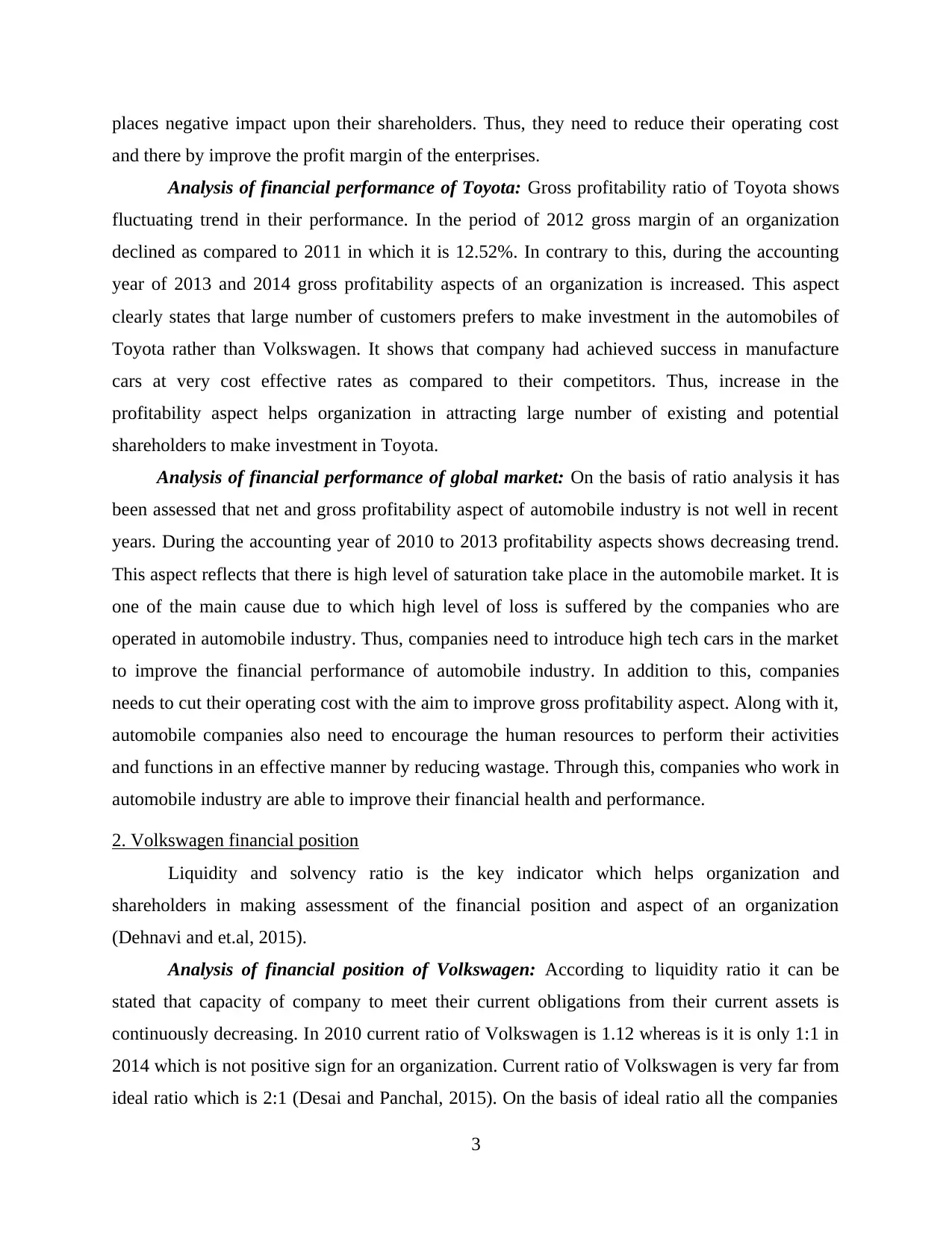
places negative impact upon their shareholders. Thus, they need to reduce their operating cost
and there by improve the profit margin of the enterprises.
Analysis of financial performance of Toyota: Gross profitability ratio of Toyota shows
fluctuating trend in their performance. In the period of 2012 gross margin of an organization
declined as compared to 2011 in which it is 12.52%. In contrary to this, during the accounting
year of 2013 and 2014 gross profitability aspects of an organization is increased. This aspect
clearly states that large number of customers prefers to make investment in the automobiles of
Toyota rather than Volkswagen. It shows that company had achieved success in manufacture
cars at very cost effective rates as compared to their competitors. Thus, increase in the
profitability aspect helps organization in attracting large number of existing and potential
shareholders to make investment in Toyota.
Analysis of financial performance of global market: On the basis of ratio analysis it has
been assessed that net and gross profitability aspect of automobile industry is not well in recent
years. During the accounting year of 2010 to 2013 profitability aspects shows decreasing trend.
This aspect reflects that there is high level of saturation take place in the automobile market. It is
one of the main cause due to which high level of loss is suffered by the companies who are
operated in automobile industry. Thus, companies need to introduce high tech cars in the market
to improve the financial performance of automobile industry. In addition to this, companies
needs to cut their operating cost with the aim to improve gross profitability aspect. Along with it,
automobile companies also need to encourage the human resources to perform their activities
and functions in an effective manner by reducing wastage. Through this, companies who work in
automobile industry are able to improve their financial health and performance.
2. Volkswagen financial position
Liquidity and solvency ratio is the key indicator which helps organization and
shareholders in making assessment of the financial position and aspect of an organization
(Dehnavi and et.al, 2015).
Analysis of financial position of Volkswagen: According to liquidity ratio it can be
stated that capacity of company to meet their current obligations from their current assets is
continuously decreasing. In 2010 current ratio of Volkswagen is 1.12 whereas is it is only 1:1 in
2014 which is not positive sign for an organization. Current ratio of Volkswagen is very far from
ideal ratio which is 2:1 (Desai and Panchal, 2015). On the basis of ideal ratio all the companies
3
and there by improve the profit margin of the enterprises.
Analysis of financial performance of Toyota: Gross profitability ratio of Toyota shows
fluctuating trend in their performance. In the period of 2012 gross margin of an organization
declined as compared to 2011 in which it is 12.52%. In contrary to this, during the accounting
year of 2013 and 2014 gross profitability aspects of an organization is increased. This aspect
clearly states that large number of customers prefers to make investment in the automobiles of
Toyota rather than Volkswagen. It shows that company had achieved success in manufacture
cars at very cost effective rates as compared to their competitors. Thus, increase in the
profitability aspect helps organization in attracting large number of existing and potential
shareholders to make investment in Toyota.
Analysis of financial performance of global market: On the basis of ratio analysis it has
been assessed that net and gross profitability aspect of automobile industry is not well in recent
years. During the accounting year of 2010 to 2013 profitability aspects shows decreasing trend.
This aspect reflects that there is high level of saturation take place in the automobile market. It is
one of the main cause due to which high level of loss is suffered by the companies who are
operated in automobile industry. Thus, companies need to introduce high tech cars in the market
to improve the financial performance of automobile industry. In addition to this, companies
needs to cut their operating cost with the aim to improve gross profitability aspect. Along with it,
automobile companies also need to encourage the human resources to perform their activities
and functions in an effective manner by reducing wastage. Through this, companies who work in
automobile industry are able to improve their financial health and performance.
2. Volkswagen financial position
Liquidity and solvency ratio is the key indicator which helps organization and
shareholders in making assessment of the financial position and aspect of an organization
(Dehnavi and et.al, 2015).
Analysis of financial position of Volkswagen: According to liquidity ratio it can be
stated that capacity of company to meet their current obligations from their current assets is
continuously decreasing. In 2010 current ratio of Volkswagen is 1.12 whereas is it is only 1:1 in
2014 which is not positive sign for an organization. Current ratio of Volkswagen is very far from
ideal ratio which is 2:1 (Desai and Panchal, 2015). On the basis of ideal ratio all the companies
3
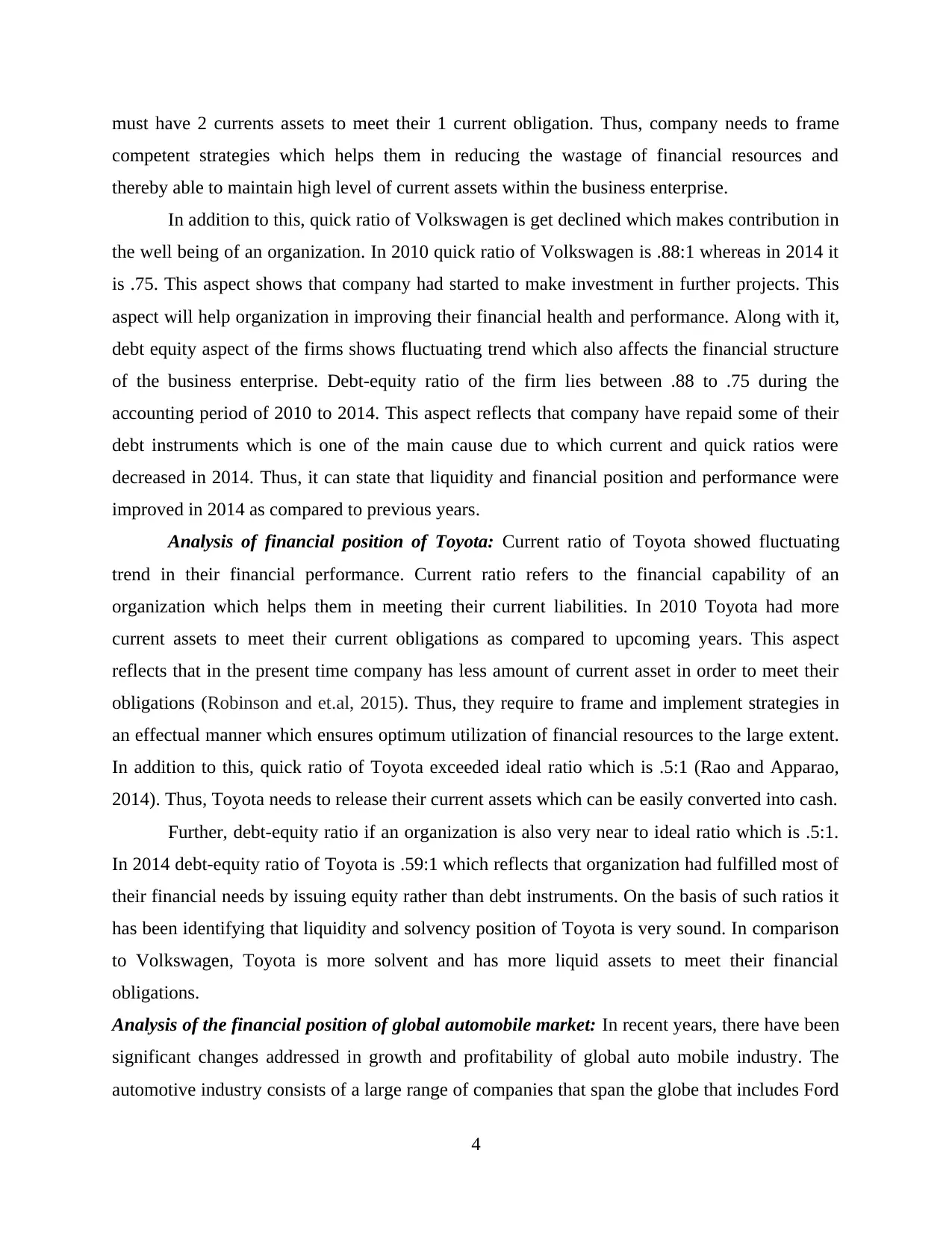
must have 2 currents assets to meet their 1 current obligation. Thus, company needs to frame
competent strategies which helps them in reducing the wastage of financial resources and
thereby able to maintain high level of current assets within the business enterprise.
In addition to this, quick ratio of Volkswagen is get declined which makes contribution in
the well being of an organization. In 2010 quick ratio of Volkswagen is .88:1 whereas in 2014 it
is .75. This aspect shows that company had started to make investment in further projects. This
aspect will help organization in improving their financial health and performance. Along with it,
debt equity aspect of the firms shows fluctuating trend which also affects the financial structure
of the business enterprise. Debt-equity ratio of the firm lies between .88 to .75 during the
accounting period of 2010 to 2014. This aspect reflects that company have repaid some of their
debt instruments which is one of the main cause due to which current and quick ratios were
decreased in 2014. Thus, it can state that liquidity and financial position and performance were
improved in 2014 as compared to previous years.
Analysis of financial position of Toyota: Current ratio of Toyota showed fluctuating
trend in their financial performance. Current ratio refers to the financial capability of an
organization which helps them in meeting their current liabilities. In 2010 Toyota had more
current assets to meet their current obligations as compared to upcoming years. This aspect
reflects that in the present time company has less amount of current asset in order to meet their
obligations (Robinson and et.al, 2015). Thus, they require to frame and implement strategies in
an effectual manner which ensures optimum utilization of financial resources to the large extent.
In addition to this, quick ratio of Toyota exceeded ideal ratio which is .5:1 (Rao and Apparao,
2014). Thus, Toyota needs to release their current assets which can be easily converted into cash.
Further, debt-equity ratio if an organization is also very near to ideal ratio which is .5:1.
In 2014 debt-equity ratio of Toyota is .59:1 which reflects that organization had fulfilled most of
their financial needs by issuing equity rather than debt instruments. On the basis of such ratios it
has been identifying that liquidity and solvency position of Toyota is very sound. In comparison
to Volkswagen, Toyota is more solvent and has more liquid assets to meet their financial
obligations.
Analysis of the financial position of global automobile market: In recent years, there have been
significant changes addressed in growth and profitability of global auto mobile industry. The
automotive industry consists of a large range of companies that span the globe that includes Ford
4
competent strategies which helps them in reducing the wastage of financial resources and
thereby able to maintain high level of current assets within the business enterprise.
In addition to this, quick ratio of Volkswagen is get declined which makes contribution in
the well being of an organization. In 2010 quick ratio of Volkswagen is .88:1 whereas in 2014 it
is .75. This aspect shows that company had started to make investment in further projects. This
aspect will help organization in improving their financial health and performance. Along with it,
debt equity aspect of the firms shows fluctuating trend which also affects the financial structure
of the business enterprise. Debt-equity ratio of the firm lies between .88 to .75 during the
accounting period of 2010 to 2014. This aspect reflects that company have repaid some of their
debt instruments which is one of the main cause due to which current and quick ratios were
decreased in 2014. Thus, it can state that liquidity and financial position and performance were
improved in 2014 as compared to previous years.
Analysis of financial position of Toyota: Current ratio of Toyota showed fluctuating
trend in their financial performance. Current ratio refers to the financial capability of an
organization which helps them in meeting their current liabilities. In 2010 Toyota had more
current assets to meet their current obligations as compared to upcoming years. This aspect
reflects that in the present time company has less amount of current asset in order to meet their
obligations (Robinson and et.al, 2015). Thus, they require to frame and implement strategies in
an effectual manner which ensures optimum utilization of financial resources to the large extent.
In addition to this, quick ratio of Toyota exceeded ideal ratio which is .5:1 (Rao and Apparao,
2014). Thus, Toyota needs to release their current assets which can be easily converted into cash.
Further, debt-equity ratio if an organization is also very near to ideal ratio which is .5:1.
In 2014 debt-equity ratio of Toyota is .59:1 which reflects that organization had fulfilled most of
their financial needs by issuing equity rather than debt instruments. On the basis of such ratios it
has been identifying that liquidity and solvency position of Toyota is very sound. In comparison
to Volkswagen, Toyota is more solvent and has more liquid assets to meet their financial
obligations.
Analysis of the financial position of global automobile market: In recent years, there have been
significant changes addressed in growth and profitability of global auto mobile industry. The
automotive industry consists of a large range of companies that span the globe that includes Ford
4
⊘ This is a preview!⊘
Do you want full access?
Subscribe today to unlock all pages.

Trusted by 1+ million students worldwide
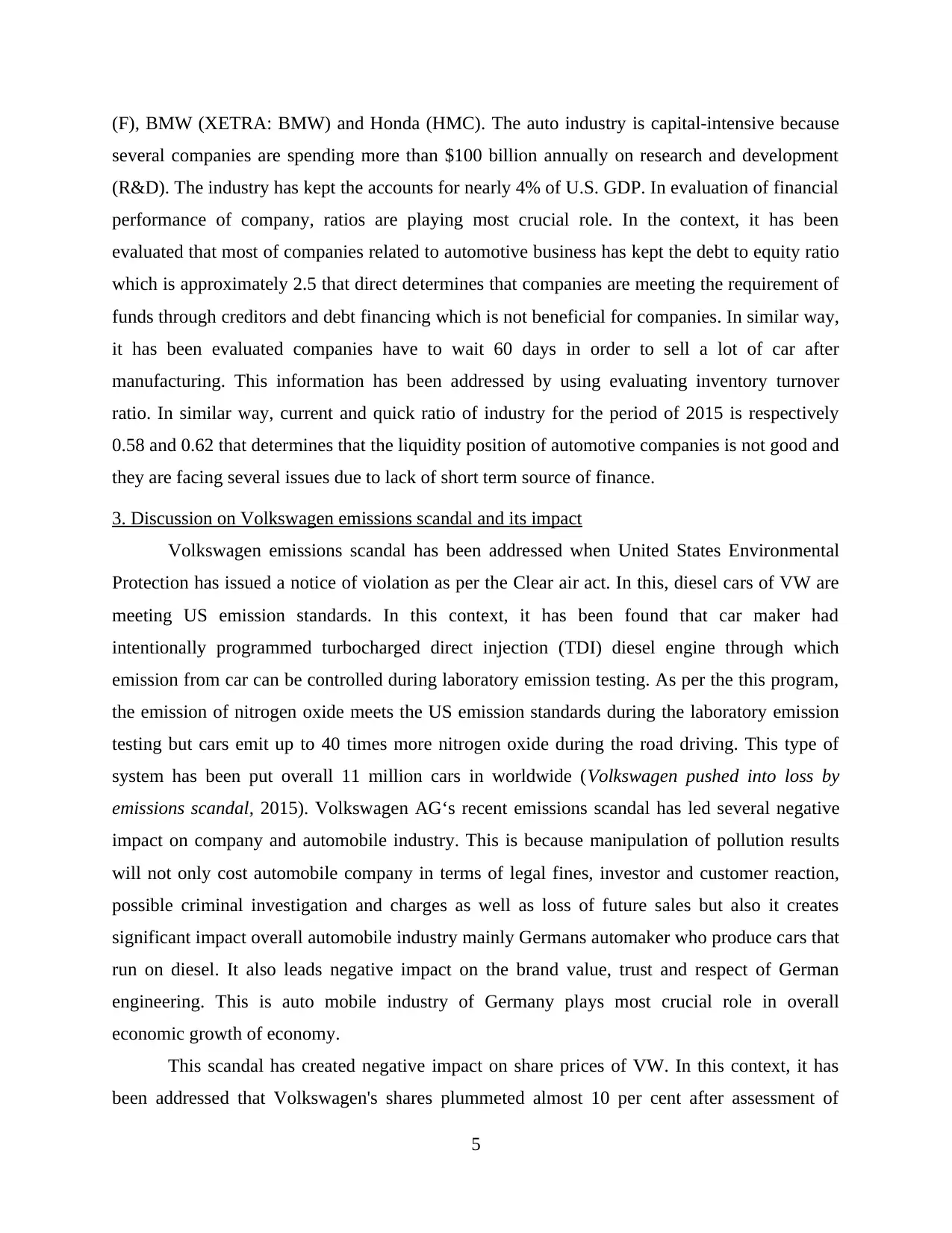
(F), BMW (XETRA: BMW) and Honda (HMC). The auto industry is capital-intensive because
several companies are spending more than $100 billion annually on research and development
(R&D). The industry has kept the accounts for nearly 4% of U.S. GDP. In evaluation of financial
performance of company, ratios are playing most crucial role. In the context, it has been
evaluated that most of companies related to automotive business has kept the debt to equity ratio
which is approximately 2.5 that direct determines that companies are meeting the requirement of
funds through creditors and debt financing which is not beneficial for companies. In similar way,
it has been evaluated companies have to wait 60 days in order to sell a lot of car after
manufacturing. This information has been addressed by using evaluating inventory turnover
ratio. In similar way, current and quick ratio of industry for the period of 2015 is respectively
0.58 and 0.62 that determines that the liquidity position of automotive companies is not good and
they are facing several issues due to lack of short term source of finance.
3. Discussion on Volkswagen emissions scandal and its impact
Volkswagen emissions scandal has been addressed when United States Environmental
Protection has issued a notice of violation as per the Clear air act. In this, diesel cars of VW are
meeting US emission standards. In this context, it has been found that car maker had
intentionally programmed turbocharged direct injection (TDI) diesel engine through which
emission from car can be controlled during laboratory emission testing. As per the this program,
the emission of nitrogen oxide meets the US emission standards during the laboratory emission
testing but cars emit up to 40 times more nitrogen oxide during the road driving. This type of
system has been put overall 11 million cars in worldwide (Volkswagen pushed into loss by
emissions scandal, 2015). Volkswagen AG‘s recent emissions scandal has led several negative
impact on company and automobile industry. This is because manipulation of pollution results
will not only cost automobile company in terms of legal fines, investor and customer reaction,
possible criminal investigation and charges as well as loss of future sales but also it creates
significant impact overall automobile industry mainly Germans automaker who produce cars that
run on diesel. It also leads negative impact on the brand value, trust and respect of German
engineering. This is auto mobile industry of Germany plays most crucial role in overall
economic growth of economy.
This scandal has created negative impact on share prices of VW. In this context, it has
been addressed that Volkswagen's shares plummeted almost 10 per cent after assessment of
5
several companies are spending more than $100 billion annually on research and development
(R&D). The industry has kept the accounts for nearly 4% of U.S. GDP. In evaluation of financial
performance of company, ratios are playing most crucial role. In the context, it has been
evaluated that most of companies related to automotive business has kept the debt to equity ratio
which is approximately 2.5 that direct determines that companies are meeting the requirement of
funds through creditors and debt financing which is not beneficial for companies. In similar way,
it has been evaluated companies have to wait 60 days in order to sell a lot of car after
manufacturing. This information has been addressed by using evaluating inventory turnover
ratio. In similar way, current and quick ratio of industry for the period of 2015 is respectively
0.58 and 0.62 that determines that the liquidity position of automotive companies is not good and
they are facing several issues due to lack of short term source of finance.
3. Discussion on Volkswagen emissions scandal and its impact
Volkswagen emissions scandal has been addressed when United States Environmental
Protection has issued a notice of violation as per the Clear air act. In this, diesel cars of VW are
meeting US emission standards. In this context, it has been found that car maker had
intentionally programmed turbocharged direct injection (TDI) diesel engine through which
emission from car can be controlled during laboratory emission testing. As per the this program,
the emission of nitrogen oxide meets the US emission standards during the laboratory emission
testing but cars emit up to 40 times more nitrogen oxide during the road driving. This type of
system has been put overall 11 million cars in worldwide (Volkswagen pushed into loss by
emissions scandal, 2015). Volkswagen AG‘s recent emissions scandal has led several negative
impact on company and automobile industry. This is because manipulation of pollution results
will not only cost automobile company in terms of legal fines, investor and customer reaction,
possible criminal investigation and charges as well as loss of future sales but also it creates
significant impact overall automobile industry mainly Germans automaker who produce cars that
run on diesel. It also leads negative impact on the brand value, trust and respect of German
engineering. This is auto mobile industry of Germany plays most crucial role in overall
economic growth of economy.
This scandal has created negative impact on share prices of VW. In this context, it has
been addressed that Volkswagen's shares plummeted almost 10 per cent after assessment of
5
Paraphrase This Document
Need a fresh take? Get an instant paraphrase of this document with our AI Paraphraser
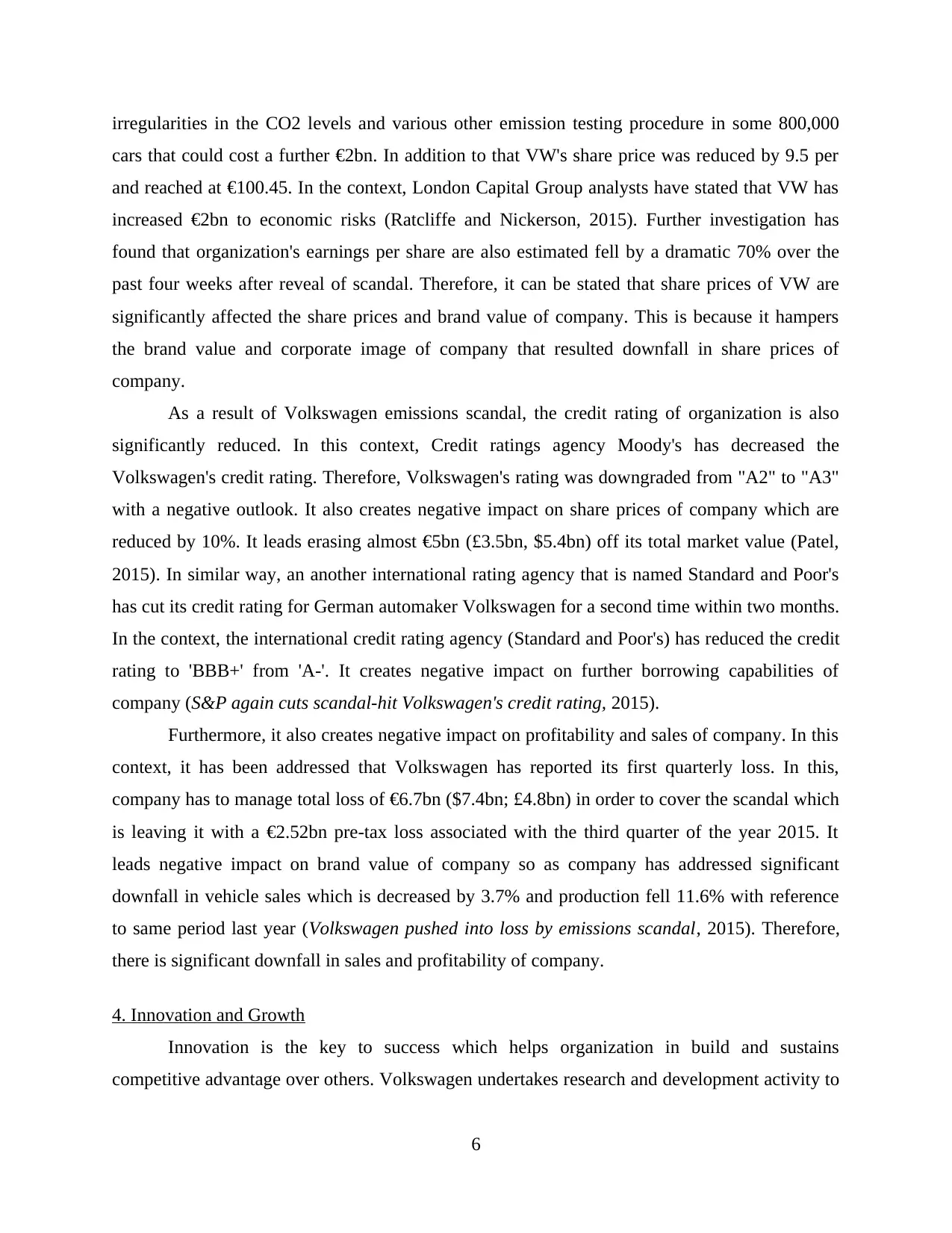
irregularities in the CO2 levels and various other emission testing procedure in some 800,000
cars that could cost a further €2bn. In addition to that VW's share price was reduced by 9.5 per
and reached at €100.45. In the context, London Capital Group analysts have stated that VW has
increased €2bn to economic risks (Ratcliffe and Nickerson, 2015). Further investigation has
found that organization's earnings per share are also estimated fell by a dramatic 70% over the
past four weeks after reveal of scandal. Therefore, it can be stated that share prices of VW are
significantly affected the share prices and brand value of company. This is because it hampers
the brand value and corporate image of company that resulted downfall in share prices of
company.
As a result of Volkswagen emissions scandal, the credit rating of organization is also
significantly reduced. In this context, Credit ratings agency Moody's has decreased the
Volkswagen's credit rating. Therefore, Volkswagen's rating was downgraded from "A2" to "A3"
with a negative outlook. It also creates negative impact on share prices of company which are
reduced by 10%. It leads erasing almost €5bn (£3.5bn, $5.4bn) off its total market value (Patel,
2015). In similar way, an another international rating agency that is named Standard and Poor's
has cut its credit rating for German automaker Volkswagen for a second time within two months.
In the context, the international credit rating agency (Standard and Poor's) has reduced the credit
rating to 'BBB+' from 'A-'. It creates negative impact on further borrowing capabilities of
company (S&P again cuts scandal-hit Volkswagen's credit rating, 2015).
Furthermore, it also creates negative impact on profitability and sales of company. In this
context, it has been addressed that Volkswagen has reported its first quarterly loss. In this,
company has to manage total loss of €6.7bn ($7.4bn; £4.8bn) in order to cover the scandal which
is leaving it with a €2.52bn pre-tax loss associated with the third quarter of the year 2015. It
leads negative impact on brand value of company so as company has addressed significant
downfall in vehicle sales which is decreased by 3.7% and production fell 11.6% with reference
to same period last year (Volkswagen pushed into loss by emissions scandal, 2015). Therefore,
there is significant downfall in sales and profitability of company.
4. Innovation and Growth
Innovation is the key to success which helps organization in build and sustains
competitive advantage over others. Volkswagen undertakes research and development activity to
6
cars that could cost a further €2bn. In addition to that VW's share price was reduced by 9.5 per
and reached at €100.45. In the context, London Capital Group analysts have stated that VW has
increased €2bn to economic risks (Ratcliffe and Nickerson, 2015). Further investigation has
found that organization's earnings per share are also estimated fell by a dramatic 70% over the
past four weeks after reveal of scandal. Therefore, it can be stated that share prices of VW are
significantly affected the share prices and brand value of company. This is because it hampers
the brand value and corporate image of company that resulted downfall in share prices of
company.
As a result of Volkswagen emissions scandal, the credit rating of organization is also
significantly reduced. In this context, Credit ratings agency Moody's has decreased the
Volkswagen's credit rating. Therefore, Volkswagen's rating was downgraded from "A2" to "A3"
with a negative outlook. It also creates negative impact on share prices of company which are
reduced by 10%. It leads erasing almost €5bn (£3.5bn, $5.4bn) off its total market value (Patel,
2015). In similar way, an another international rating agency that is named Standard and Poor's
has cut its credit rating for German automaker Volkswagen for a second time within two months.
In the context, the international credit rating agency (Standard and Poor's) has reduced the credit
rating to 'BBB+' from 'A-'. It creates negative impact on further borrowing capabilities of
company (S&P again cuts scandal-hit Volkswagen's credit rating, 2015).
Furthermore, it also creates negative impact on profitability and sales of company. In this
context, it has been addressed that Volkswagen has reported its first quarterly loss. In this,
company has to manage total loss of €6.7bn ($7.4bn; £4.8bn) in order to cover the scandal which
is leaving it with a €2.52bn pre-tax loss associated with the third quarter of the year 2015. It
leads negative impact on brand value of company so as company has addressed significant
downfall in vehicle sales which is decreased by 3.7% and production fell 11.6% with reference
to same period last year (Volkswagen pushed into loss by emissions scandal, 2015). Therefore,
there is significant downfall in sales and profitability of company.
4. Innovation and Growth
Innovation is the key to success which helps organization in build and sustains
competitive advantage over others. Volkswagen undertakes research and development activity to
6

identify the best or latest technology. Through this, Volkswagen is able to offer unique cars with
high tech designs or model as compared to the other rival firm. In the present era, people give
more priority to comfort and features of the car rather than price. Usually, people are ready to
pay extra for the unique models or designs of the car (Srinivasan and Karthikeyan, 2015). It
creates opportunity in front of Volkswagen to conduct in depth research which enables them to
manufacture the cars which save petrol and diesel.
In addition this, company also needs to make effort to identify the technology which
helps them in reducing the air pollution to the large extent. Moreover, customers also consider
the environmental aspects while they make purchase of car (Wang, 2014). Thus, by
manufacturing and there by offering Eco-friendly cars Volkswagen can attract large number of
customers. Volkswagen can build distinct image in the mind of their existing and potential
customers by offering unique features to them. It enables company to maximize their sales as
well as gross margin there by make contribution in the growth and development of an
organization (Revsine and et.al, 2005).
5. Future prospectus of Volkswagen
Volkswagen is planning to launch new cars to grab the opportunities which are present in
the automobile market. It is focusing on the concept of powertrain, body operation and safety
aspects or features. With this aim Volkswagen is planning is to launch Beetle, passat, Tiguan
Suv, Sub-compact sedan and compact SUV in the global market. By introducing unique or
innovative features and designs Volkswagen wants to attract large number of customers. It
enables Volkswagen to improve their profitability and liquidity aspects. In addition to this,
Volkswagen is planning to cut their operating cost to cope with the emission scandal of an
organization. The company estimates that cost of emission scandal will be approximately 40
billion. Thus, by reducing the operating cost Volkswagen is able to cope with the cost of such
scandal. For this purpose, company prefers to cut the cost in terms of investment program, labor
and supplier cost (Zhou, 2014). It enables organization to improve their financial performance
and thereby helps company in getting success in the dynamic business environment.
7
high tech designs or model as compared to the other rival firm. In the present era, people give
more priority to comfort and features of the car rather than price. Usually, people are ready to
pay extra for the unique models or designs of the car (Srinivasan and Karthikeyan, 2015). It
creates opportunity in front of Volkswagen to conduct in depth research which enables them to
manufacture the cars which save petrol and diesel.
In addition this, company also needs to make effort to identify the technology which
helps them in reducing the air pollution to the large extent. Moreover, customers also consider
the environmental aspects while they make purchase of car (Wang, 2014). Thus, by
manufacturing and there by offering Eco-friendly cars Volkswagen can attract large number of
customers. Volkswagen can build distinct image in the mind of their existing and potential
customers by offering unique features to them. It enables company to maximize their sales as
well as gross margin there by make contribution in the growth and development of an
organization (Revsine and et.al, 2005).
5. Future prospectus of Volkswagen
Volkswagen is planning to launch new cars to grab the opportunities which are present in
the automobile market. It is focusing on the concept of powertrain, body operation and safety
aspects or features. With this aim Volkswagen is planning is to launch Beetle, passat, Tiguan
Suv, Sub-compact sedan and compact SUV in the global market. By introducing unique or
innovative features and designs Volkswagen wants to attract large number of customers. It
enables Volkswagen to improve their profitability and liquidity aspects. In addition to this,
Volkswagen is planning to cut their operating cost to cope with the emission scandal of an
organization. The company estimates that cost of emission scandal will be approximately 40
billion. Thus, by reducing the operating cost Volkswagen is able to cope with the cost of such
scandal. For this purpose, company prefers to cut the cost in terms of investment program, labor
and supplier cost (Zhou, 2014). It enables organization to improve their financial performance
and thereby helps company in getting success in the dynamic business environment.
7
⊘ This is a preview!⊘
Do you want full access?
Subscribe today to unlock all pages.

Trusted by 1+ million students worldwide
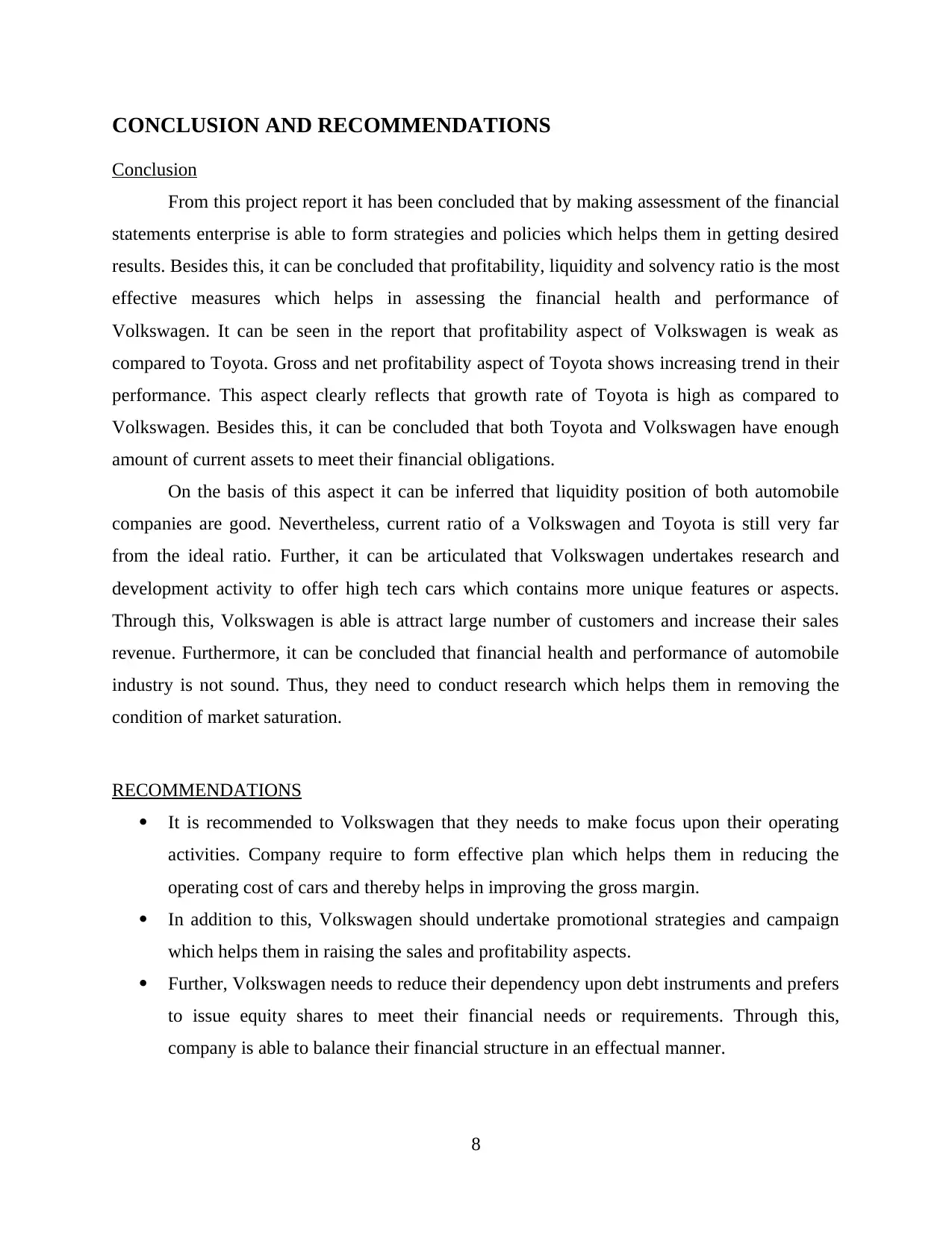
CONCLUSION AND RECOMMENDATIONS
Conclusion
From this project report it has been concluded that by making assessment of the financial
statements enterprise is able to form strategies and policies which helps them in getting desired
results. Besides this, it can be concluded that profitability, liquidity and solvency ratio is the most
effective measures which helps in assessing the financial health and performance of
Volkswagen. It can be seen in the report that profitability aspect of Volkswagen is weak as
compared to Toyota. Gross and net profitability aspect of Toyota shows increasing trend in their
performance. This aspect clearly reflects that growth rate of Toyota is high as compared to
Volkswagen. Besides this, it can be concluded that both Toyota and Volkswagen have enough
amount of current assets to meet their financial obligations.
On the basis of this aspect it can be inferred that liquidity position of both automobile
companies are good. Nevertheless, current ratio of a Volkswagen and Toyota is still very far
from the ideal ratio. Further, it can be articulated that Volkswagen undertakes research and
development activity to offer high tech cars which contains more unique features or aspects.
Through this, Volkswagen is able is attract large number of customers and increase their sales
revenue. Furthermore, it can be concluded that financial health and performance of automobile
industry is not sound. Thus, they need to conduct research which helps them in removing the
condition of market saturation.
RECOMMENDATIONS
It is recommended to Volkswagen that they needs to make focus upon their operating
activities. Company require to form effective plan which helps them in reducing the
operating cost of cars and thereby helps in improving the gross margin.
In addition to this, Volkswagen should undertake promotional strategies and campaign
which helps them in raising the sales and profitability aspects.
Further, Volkswagen needs to reduce their dependency upon debt instruments and prefers
to issue equity shares to meet their financial needs or requirements. Through this,
company is able to balance their financial structure in an effectual manner.
8
Conclusion
From this project report it has been concluded that by making assessment of the financial
statements enterprise is able to form strategies and policies which helps them in getting desired
results. Besides this, it can be concluded that profitability, liquidity and solvency ratio is the most
effective measures which helps in assessing the financial health and performance of
Volkswagen. It can be seen in the report that profitability aspect of Volkswagen is weak as
compared to Toyota. Gross and net profitability aspect of Toyota shows increasing trend in their
performance. This aspect clearly reflects that growth rate of Toyota is high as compared to
Volkswagen. Besides this, it can be concluded that both Toyota and Volkswagen have enough
amount of current assets to meet their financial obligations.
On the basis of this aspect it can be inferred that liquidity position of both automobile
companies are good. Nevertheless, current ratio of a Volkswagen and Toyota is still very far
from the ideal ratio. Further, it can be articulated that Volkswagen undertakes research and
development activity to offer high tech cars which contains more unique features or aspects.
Through this, Volkswagen is able is attract large number of customers and increase their sales
revenue. Furthermore, it can be concluded that financial health and performance of automobile
industry is not sound. Thus, they need to conduct research which helps them in removing the
condition of market saturation.
RECOMMENDATIONS
It is recommended to Volkswagen that they needs to make focus upon their operating
activities. Company require to form effective plan which helps them in reducing the
operating cost of cars and thereby helps in improving the gross margin.
In addition to this, Volkswagen should undertake promotional strategies and campaign
which helps them in raising the sales and profitability aspects.
Further, Volkswagen needs to reduce their dependency upon debt instruments and prefers
to issue equity shares to meet their financial needs or requirements. Through this,
company is able to balance their financial structure in an effectual manner.
8
Paraphrase This Document
Need a fresh take? Get an instant paraphrase of this document with our AI Paraphraser
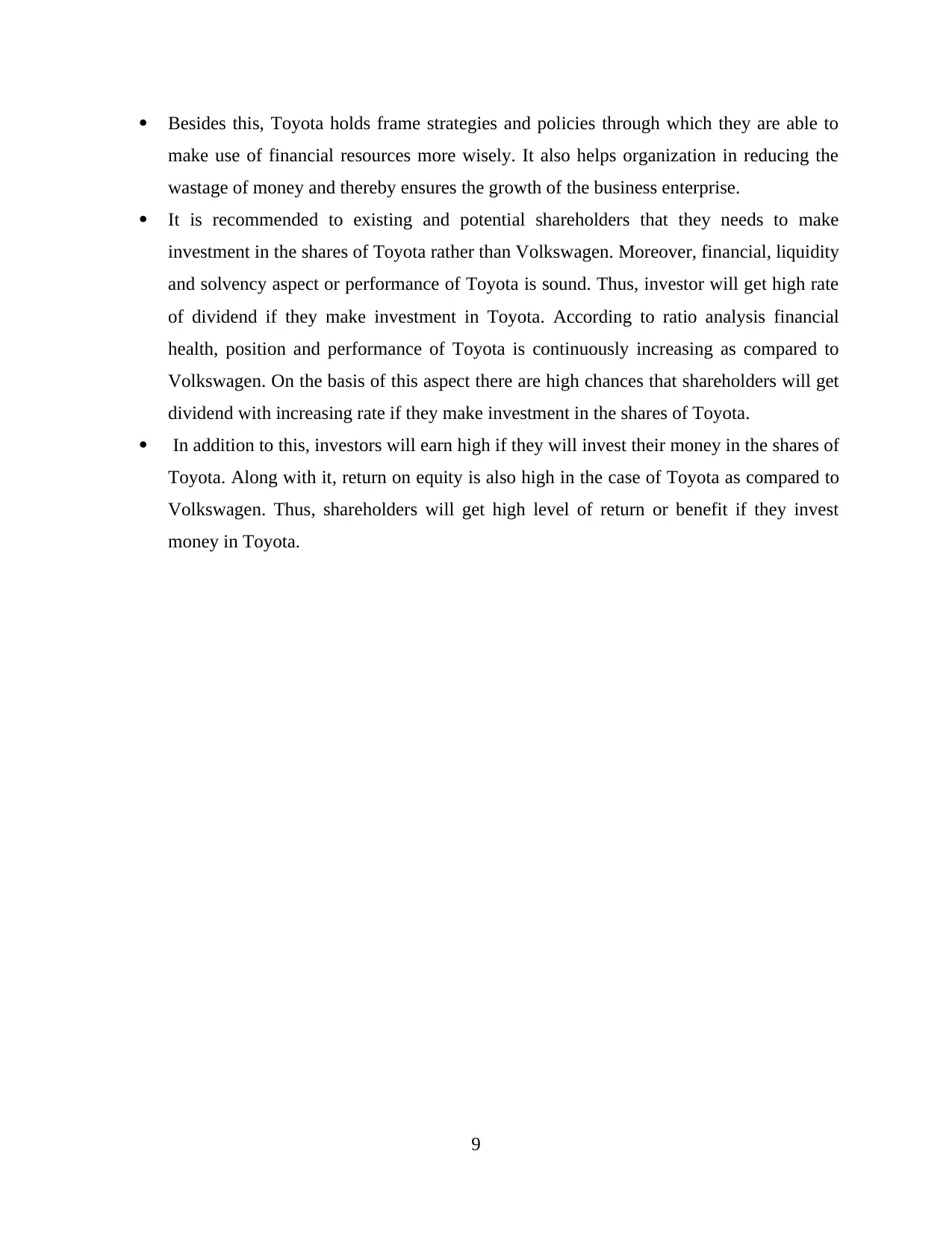
Besides this, Toyota holds frame strategies and policies through which they are able to
make use of financial resources more wisely. It also helps organization in reducing the
wastage of money and thereby ensures the growth of the business enterprise.
It is recommended to existing and potential shareholders that they needs to make
investment in the shares of Toyota rather than Volkswagen. Moreover, financial, liquidity
and solvency aspect or performance of Toyota is sound. Thus, investor will get high rate
of dividend if they make investment in Toyota. According to ratio analysis financial
health, position and performance of Toyota is continuously increasing as compared to
Volkswagen. On the basis of this aspect there are high chances that shareholders will get
dividend with increasing rate if they make investment in the shares of Toyota.
In addition to this, investors will earn high if they will invest their money in the shares of
Toyota. Along with it, return on equity is also high in the case of Toyota as compared to
Volkswagen. Thus, shareholders will get high level of return or benefit if they invest
money in Toyota.
9
make use of financial resources more wisely. It also helps organization in reducing the
wastage of money and thereby ensures the growth of the business enterprise.
It is recommended to existing and potential shareholders that they needs to make
investment in the shares of Toyota rather than Volkswagen. Moreover, financial, liquidity
and solvency aspect or performance of Toyota is sound. Thus, investor will get high rate
of dividend if they make investment in Toyota. According to ratio analysis financial
health, position and performance of Toyota is continuously increasing as compared to
Volkswagen. On the basis of this aspect there are high chances that shareholders will get
dividend with increasing rate if they make investment in the shares of Toyota.
In addition to this, investors will earn high if they will invest their money in the shares of
Toyota. Along with it, return on equity is also high in the case of Toyota as compared to
Volkswagen. Thus, shareholders will get high level of return or benefit if they invest
money in Toyota.
9
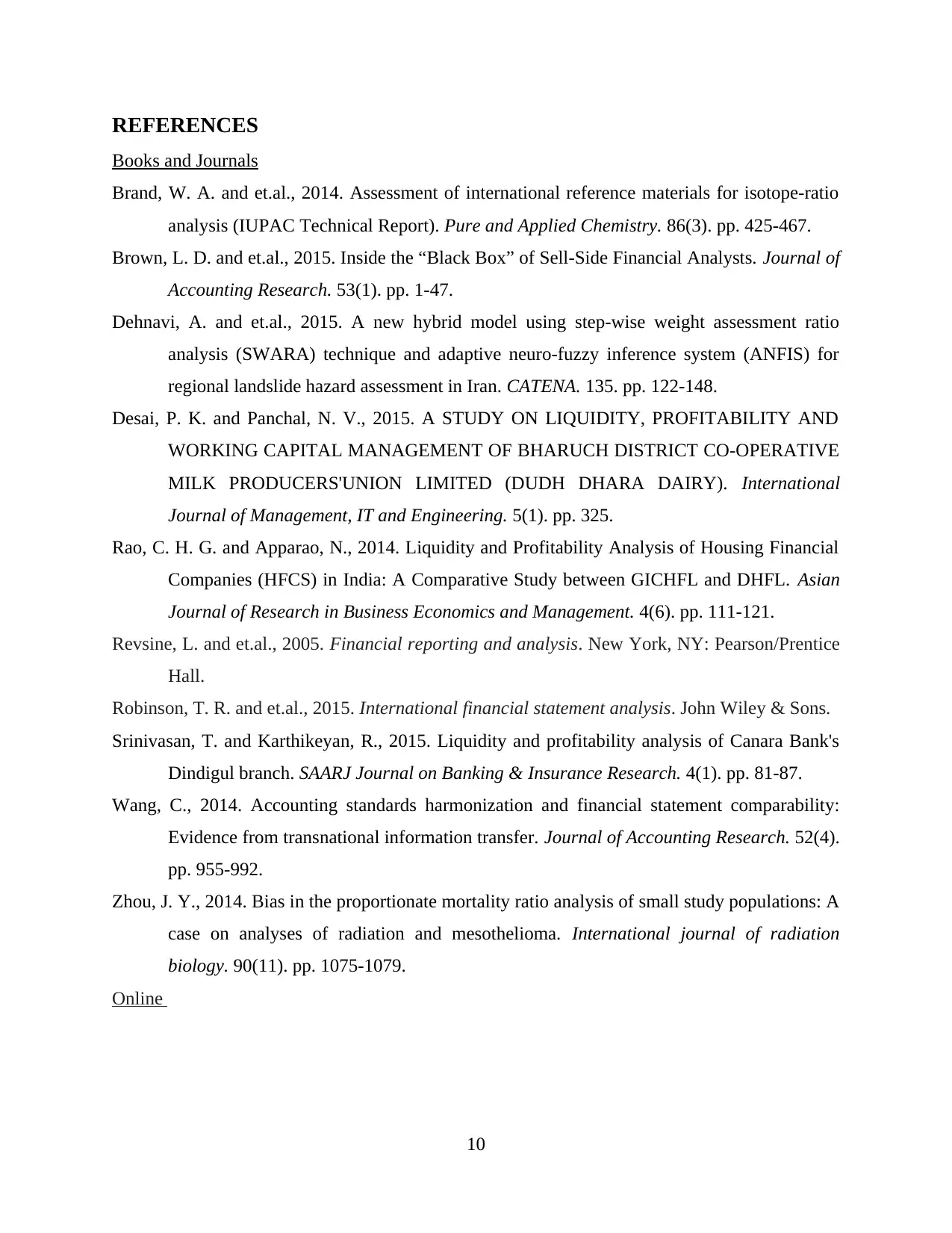
REFERENCES
Books and Journals
Brand, W. A. and et.al., 2014. Assessment of international reference materials for isotope-ratio
analysis (IUPAC Technical Report). Pure and Applied Chemistry. 86(3). pp. 425-467.
Brown, L. D. and et.al., 2015. Inside the “Black Box” of Sell‐Side Financial Analysts. Journal of
Accounting Research. 53(1). pp. 1-47.
Dehnavi, A. and et.al., 2015. A new hybrid model using step-wise weight assessment ratio
analysis (SWARA) technique and adaptive neuro-fuzzy inference system (ANFIS) for
regional landslide hazard assessment in Iran. CATENA. 135. pp. 122-148.
Desai, P. K. and Panchal, N. V., 2015. A STUDY ON LIQUIDITY, PROFITABILITY AND
WORKING CAPITAL MANAGEMENT OF BHARUCH DISTRICT CO-OPERATIVE
MILK PRODUCERS'UNION LIMITED (DUDH DHARA DAIRY). International
Journal of Management, IT and Engineering. 5(1). pp. 325.
Rao, C. H. G. and Apparao, N., 2014. Liquidity and Profitability Analysis of Housing Financial
Companies (HFCS) in India: A Comparative Study between GICHFL and DHFL. Asian
Journal of Research in Business Economics and Management. 4(6). pp. 111-121.
Revsine, L. and et.al., 2005. Financial reporting and analysis. New York, NY: Pearson/Prentice
Hall.
Robinson, T. R. and et.al., 2015. International financial statement analysis. John Wiley & Sons.
Srinivasan, T. and Karthikeyan, R., 2015. Liquidity and profitability analysis of Canara Bank's
Dindigul branch. SAARJ Journal on Banking & Insurance Research. 4(1). pp. 81-87.
Wang, C., 2014. Accounting standards harmonization and financial statement comparability:
Evidence from transnational information transfer. Journal of Accounting Research. 52(4).
pp. 955-992.
Zhou, J. Y., 2014. Bias in the proportionate mortality ratio analysis of small study populations: A
case on analyses of radiation and mesothelioma. International journal of radiation
biology. 90(11). pp. 1075-1079.
Online
10
Books and Journals
Brand, W. A. and et.al., 2014. Assessment of international reference materials for isotope-ratio
analysis (IUPAC Technical Report). Pure and Applied Chemistry. 86(3). pp. 425-467.
Brown, L. D. and et.al., 2015. Inside the “Black Box” of Sell‐Side Financial Analysts. Journal of
Accounting Research. 53(1). pp. 1-47.
Dehnavi, A. and et.al., 2015. A new hybrid model using step-wise weight assessment ratio
analysis (SWARA) technique and adaptive neuro-fuzzy inference system (ANFIS) for
regional landslide hazard assessment in Iran. CATENA. 135. pp. 122-148.
Desai, P. K. and Panchal, N. V., 2015. A STUDY ON LIQUIDITY, PROFITABILITY AND
WORKING CAPITAL MANAGEMENT OF BHARUCH DISTRICT CO-OPERATIVE
MILK PRODUCERS'UNION LIMITED (DUDH DHARA DAIRY). International
Journal of Management, IT and Engineering. 5(1). pp. 325.
Rao, C. H. G. and Apparao, N., 2014. Liquidity and Profitability Analysis of Housing Financial
Companies (HFCS) in India: A Comparative Study between GICHFL and DHFL. Asian
Journal of Research in Business Economics and Management. 4(6). pp. 111-121.
Revsine, L. and et.al., 2005. Financial reporting and analysis. New York, NY: Pearson/Prentice
Hall.
Robinson, T. R. and et.al., 2015. International financial statement analysis. John Wiley & Sons.
Srinivasan, T. and Karthikeyan, R., 2015. Liquidity and profitability analysis of Canara Bank's
Dindigul branch. SAARJ Journal on Banking & Insurance Research. 4(1). pp. 81-87.
Wang, C., 2014. Accounting standards harmonization and financial statement comparability:
Evidence from transnational information transfer. Journal of Accounting Research. 52(4).
pp. 955-992.
Zhou, J. Y., 2014. Bias in the proportionate mortality ratio analysis of small study populations: A
case on analyses of radiation and mesothelioma. International journal of radiation
biology. 90(11). pp. 1075-1079.
Online
10
⊘ This is a preview!⊘
Do you want full access?
Subscribe today to unlock all pages.

Trusted by 1+ million students worldwide
1 out of 16
Related Documents
Your All-in-One AI-Powered Toolkit for Academic Success.
+13062052269
info@desklib.com
Available 24*7 on WhatsApp / Email
![[object Object]](/_next/static/media/star-bottom.7253800d.svg)
Unlock your academic potential
Copyright © 2020–2026 A2Z Services. All Rights Reserved. Developed and managed by ZUCOL.





